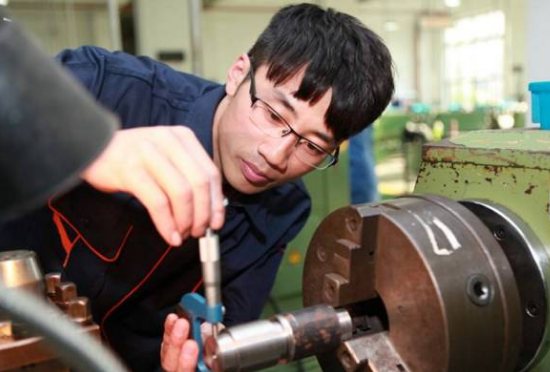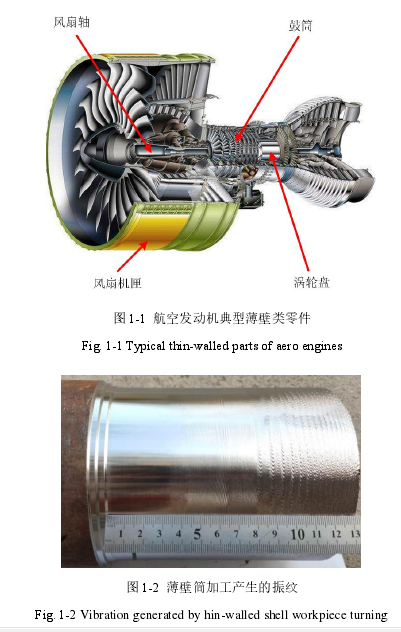摘 要
由于壁厚较薄、刚度较弱,薄壁圆柱筒工件的切削加工一直是机械行业的重点和难点。在动态切削力的作用下,工件和刀具的接触点处极易发生强烈的颤振,从而使工件表面留下振痕,严重影响加工效率及表面精度。此外,在加工过程中,由于工件材料不断被去除,以及刀具切削位置的变化,使得切削系统是一个时变系统。为此,本文从动力学建模的角度,考虑时变厚度、时变位置的影响,分析薄壁圆柱筒工件的车削固有特性,将振动系统稳定性的问题转化为临界切削宽度选取值的问题,用稳定性极限图的方式来分析切削加工的稳定性,从而在实际加工前更好的预测可能出现的振动问题。本文的主要研究内容包括:
1)建立薄壁圆柱筒工件静止态的动力学方程,采用梁函数法对固支—简支和固定—自由两种边界条件下工件的固有特性进行求解,得到其固有频率及对应振型,并采用有限元软件对工件进行模态分析,求得其静止态下的固有频率及对应振型,并进行对比,验证了有限元模型的正确性。通过分析不同厚径比、长径比的薄壁圆柱筒工件固有频率的变化规律,发现随着工件厚度的不断减小、长度不断增加,工件固有频率呈现下降趋势,但各阶模态振型会发生迁移现象。为后续稳定性分析中固有频率的求解与验证奠定了基础。
2)基于再生型颤振机理,分别建立单自由度、两自由度薄壁筒车削系统的时滞微分方程,采用解析法和半离散法分别对时滞项进行处理,得到相应的稳定性极限图,对比发现,半离散法允许在任何稳定切削条件下直接预测稳定状态,即半离散法适用性更强,更具备一般性。对于单自由度车削颤振系统动力学模型,根据相应的稳定性极限表达式,分析了不同加工参数对振动系统稳定性的影响规律;对于两自由度车削颤振系统动力学模型,重点研究了刀具与工件参数匹配的差异性对稳定性的影响,从而能够寻找到一个最佳的车削工况,在高效率加工的同时,有效避免颤振的发生。
3)考虑切削过程中时变因素的影响,分析单次走刀下工件固有频率的变化规律,针对该时变工件,建立了有限元时变模型,获得了时变有限元极限图。通过仿真分析发现采用反向车削可以有效提高车削薄弱处的稳定性;通过对时变工件模型进行分析,发现耦合系统的稳定性在总体上呈下降趋势,但在局部会出现向上波动,这与实际也是相符的。对工件参数进行时变建模与稳定性分析可以在一定程度上准确预测颤振发生位置,为后续在线监测与控制提供参考,在车床 CA6140 上进行薄壁筒工件的车削加工试验,验证了时变稳定性极限图的正确性;根据试验发现,采用两自由度耦合振动系统的稳定性预测图选取切削宽度可以更可靠地预估颤振发生率。
4)在对薄壁筒工件车削颤振稳定性理论分析的基础上,开发了刀具-工件车削颤振稳定性预测软件。该软件直接将理论分析结果可视化,辅助加工者在实际加工前寻找到稳定域更大的区域,并且能够计算出指定主轴转速下所对应的最大切削宽度,提高加工效率。开发该软件可以方便工程应用,节约理论研究成本,实现薄壁筒车削加工稳定性的可视性、精确性及加工高效性。
关键词 : 薄壁筒;颤振;时变性;稳定性;车削。
ABSTRACT
Because of thin wall thickness and weak stiffness, the machining of thin-walled cylindricalcylinder has always been the focus and difficulty of mechanical industry. Under the action ofdynamic cutting force, the workpiece and the tool contact point is easy to occur strong chatter,so that the workpiece surface left vibration marks, seriously affect the machining efficiency andsurface accuracy. In the process of machining, the cutting system is a time-varying system dueto the constant removal of the workpiece material and the change of the cutting position of thetool. Therefore, from the perspective of dynamic modeling, considering the effects of time-varying thickness and time-varying position, this paper analyzes the inherent characteristics ofthin-walled cylindrical cylinder workpiece in turning, and transforms the problem of vibrationsystem stability into the problem of selecting the value of critical cutting width. The stabilitylimit diagram is used to predict the machining stability, so as to better predict the machiningchatter before the actual machining.The main research contents of this paper include:
1)The dynamic equation of the stationary state of thin-walled cylindrical cylinderworkpiece is established.The beam function method was used to solve the inherentcharacteristics of the workpiece under two kinds of boundary conditions: fixed supported-simply supported and fixed supported -fixed free. and the natural frequencies and correspondingmode shapes were obtained. The finite element software was used to carry out modal analysison the workpiece, and the natural frequency and corresponding mode shape of the workpiecein the static state were obtained, and the comparison was made to verify the correctness of thefinite element model.By analyzing the variation of natural frequency of thin-walled cylindricalcylinder workpiece with different thickness-diameter ratio and length-diameter ratio, it is foundthat the natural frequency of the workpiece decreases with the decrease of the thickness and theincrease of the length of the workpiece, but the mode shapes of each order will migrate. It laysa foundation for solving and verifying the natural frequency in the subsequent stability analysis.

2)Based on the regenerative chatter mechanism, the delay differential equations of singleand two degrees of freedom thin-walled cylindrical turning systems are established, usinganalytic method and discrete method to deal with time delay, respectively for the stability limitdiagram. By comparing, found that the discrete method allows direct prediction in any stablecutting condition stable state, namely stronger applicability half a discrete method, more general.
For the single degree of freedom turning chatter system dynamics model, according to thecorresponding stability limit expression, the influence law of different machining parameters on the vibration system stability is analyzed.For the dynamic model of two-degree-of-freedomturning chatter system, the influence of parameter matching difference between the tool and theworkpiece on the stability is emphatically studied, so as to find an optimal turning condition,which can effectively avoid chatter while processing with high efficiency.
3)Considering the influence of time varying factors in the cutting process, the variationlaw of the natural frequency of the workpiece under single cutting was analyzed. For theworkpiece with time varying, the finite element model was established and the finite elementlimit diagram was obtained. Through simulation analysis, it is found that reverse turning caneffectively improve the stability of turning weak points. Through the analysis of the time-varying workpiece model, it is found that the stability of the coupling system tends to declinein general, but fluctuates upward in local parts. Time-varying modeling and stability analysisof workpiece parameters can accurately predict the occurrence location of flutter to a certainextent, which provides reference for the follow-up online monitoring and control. The turningexperiments of thin-walled cylinder workpiece on the CA6140 were carried out to verify thecorrectness of the time-varying stability limit diagram. According to the test results, it is foundthat the cutting width can be selected by using the stability prediction diagram of the 2DOFcoupled vibration system to predict the chatter incidence more reliably.
4)Based on the theoretical analysis of the chatter stability of thin-walled cylinderworkpiece in turning, the software for predicting the chatter stability of tool-workpiece turningis developed. The software directly materializes the theoretical analysis results and assists theprocessor to find a larger stability region before actual processing, and be able to calculate thecorresponding maximum cutting width under the specified spindle speed. The development ofthe software can facilitate the engineering application, save the cost of theoretical research, andrealize the visibility, accuracy and high efficiency of thin-wall cylinder turning stability.
Key Words : Thin-Walled Shell; Chatter; Time-varying; Stability; Turning。
第1章 绪论
1.1 、选题背景及研究意义。
高精度、高可靠性、高效率是制造技术不懈的追求目标,航空航天、能源、微电子等领域,高、精、尖复杂产品的加工生产向现代制造工艺、装备和系统的极限性能不断提出新的挑战。随着机械系统和结构向轻量化、极端化等方向快速发展,由此带来的机械加工制造过程中的振动问题更为突出。此外,“中国制造2025”也对航空航天等先进制造业提出了更高的要求。定量认识和掌握加工制造的本质规律已成为现代制造业的重中之重[1]。
薄壁筒类零件在最大限度减轻结构质量的同时,也满足了实际应用中的结构强度和使用性能要求,因此被广泛应用在航空航天等先进制造业中,如飞机长桁、整体壁板及航天发动机中的鼓筒、涡轮盘等(见图1-1)。通常这些构件的设计尺寸、位置精度及表面质量的要求较高、品种规格多,但批量小,大多采用切削加工制造。由于此类构件同时存在空间尺寸大、结构形式复杂、壁薄刚度弱、难加工材料多[2]、材料去除率高等难点,其切削工艺性往往较差、且难以添加辅助装置,在动态切削力的作用下,工件和刀具的接触点处极易发生切削颤振和加工变形,导致工件表面留有振痕(见图1-2),严重影响切削加工的效率及精度,不仅加速了刀具的损坏,还导致了零件甚至机床的报废。
车削加工过程中产生的振动,与机床结构和切削过程中工件与刀具的动态特性有着密切的联系,是一种影响因素十分复杂的机械振动现象。机床切削振动按其性质主要分为自由振动、强迫振动、自激振动、混合振动等类型[2-6]。其中,自激振动是切削过程中刀具和工件之间,由于反馈机制作用下的能量补充进而引起的一种动态不稳定现象[7],这种现象称为颤振。颤振几乎存在于所有的切削操作中,是实际加工中阻碍实现预期生产率的主要原因,被认为是切削加工中最为棘手的问题之一[2-9]。颤振对刀具、工件,甚至机床结构及其链接特性都有着重大影响;切削过程中所产生的振动,往往伴随着噪声等一系列污染,严重影响到车床操作者及其附近相关人员的身心健康;在实际加工中,为了减小、避免颤振的发生,常用手段是采取小的切削用量,这种方法大大缩减了机床的加工效率,延长了生产时间。
本文基于国家自然科学基金项目“时变因素作用下薄壁筒类工件车削振动特性与抑制方法研究”,通过理论与试验研究,着重分析了车削前的稳定性分析这一部分,探讨不同加工参数对稳定性分析的影响,重点分析了刀具与工件匹配规律对耦合振动系统稳定性的影响,从而做到在实际加工前能够准确评估加工过程中可能出现的问题以及挑选适当的加工参数与刀具,从而在保证机床和刀具切削性能得到充分发挥的前提下,突破传统上采用降低切削用量来应对振动的限制,有效减小实际车削中不必要的损失,缩短产品制造周期,大大提升加工效率。

【由于本篇文章为硕士论文,如需全文请点击底部下载全文链接】
1.2 国内外研究现状分析.
1.3 本文研究的主要内容
第2章 静止态薄壁圆柱筒工件基本理论
2.1静止态薄壁筒动力学基本方程.
2.1.1壳体力学模型.
2.1.2薄壁圆柱壳的基本方程,
2.1.3薄壁圆柱壳的动力学方程,
2.2静止态薄壁筒固有特性分析,
2.2.1薄壁圆柱筒振型概述
2.2.2薄壁圆柱筒固有特性分析
2.2.3计算实例与结果分析.
2.3.4薄壁圆柱筒固有特性分析的有限元法
2.3.5有限元法和解析法结果对比
2.3几何参数变化对薄壁筒固有特性的影响.
2.4 本章小结
第3章 单自由度薄壁筒车削颤振系统的稳定性分析
3.1再生型颤振的产生机理,
3.2单自由度颤振系统模型
3.3单自由度颤振稳定性分析
3.3.1解析法,
3.3.2半离散法,
3.4切削颤振系统稳定性影响因素分析
3.4.1主振系统刚度
3.4.2主振系统固有频率
3.4.3方向系数
3.4.4王振系统阻尼.
3.4.5重叠系数
3.4.6切削刚度系数.
3.5本章小结.
第4章 两自由度薄壁筒车削颤振系统的稳定性分析.
4.1两自由度颤振稳定性分析.
4.1.1解析法.
4.1.2半离散法.
4.2刀具与工件参数匹配的差异性对稳定性的影响
4.3薄壁圆柱筒试验分析.
4.3.1模态仿真分析,
4.3.2车削试验分析.
4.4本章小结.
第5章 刀具工件车削颤振稳定性预测软件
5.1软件结
5.2软件结构流程图.
5.3软件设计流程及程序描述.
5.3.1稳定性预测图展示窗口
5.3.2计算参数输入窗口
5.3.3方法选择窗口
5.4本章小结.
第6章 结论
本文以薄壁圆柱筒工件为研究对象,基于Love薄壳理论,分析了静止状态两种边界条件下工件的固有特性,并与有限元法进行了对比,验证了有限元模型的正确性。基于再生型颤振机理,建立了单自由度和两自由度的动力学模型,采用解析法和半离散法对时滞项进行处理,分别得到了对应的稳定性极限图,根据稳定性极限图分析了加工参数对耦合振动系统稳定性的影响;考虑切削过程中工件时变厚度及刀具时变位置的影响,分析了时变厚度下工件固有频率和稳定性的变化规律,获得了时变稳定性极限图,并进行模态试验和车削试验分析。
根据本文研究内容,得到以下结论:
(1)通过对不同厚度和长度的工件模态进行分析,发现工件固有频率随工件壁厚的减小和长度的增加而减小,但是不同阶数的模态振型会发生迁移,而振型的变化会引起工件振动特性发生改变,这也意味着在每次走刀完成后需要及时调整加工参数,从而避免颤振的发生。
(2)基于单自由度车削颤振系统动力学模型,采用解析法和半离散法对时滞项进行处理,获得相应的稳定性极限图,两种方法所得图形吻合度极高;根据稳定性极限表达式,找到影响切削系统稳定性的因素为切削参数c r rk f dk k j f和切削系统的动力学特性 nwkz,并分析了不同加工参数对振动系统稳定性的影响规律,这个规律对两自由度车削颤振系统动力学模型同样适用。
(3)基于两自由度车削颤振系统动力学模型,采用解析法和半离散法对时滞项进行处理,获得相应的稳定性极限图并进行对比,发现解析法只能求解特定加工情况下的稳定性,而半离散法允许在任何稳定切削条件下直接分析稳定状态;通过对车削中刀具与工件动力学参数的具体匹配规律进行研究分析发现,随着刀具刚度或固有频率的增大,切削稳定性的总体趋势呈现上升趋势,但过度提升刀具刚度并不会有效改善切削稳定性;当刀具与工件的固有频率接近时,耦合系统的切削稳定性反而会降低,实际加工时应避免选用该处动力学参数的刀具,从而提升整个振动系统的切削稳定性。
(4)针对单次走刀车削下的时变工件,建立了有限元时变模型,获得了时变有限元极限图。通过仿真分析对比了两种进给方向时变模型所对应的前三阶固有频率,发现采用反向车削可以有效提高车削薄弱处的稳定性;通过对时变工件模型进行分析,发现随着材料的去除以及工件不同位置刚度的变化,由主轴端到自由端工件固有频率呈下降趋势,且靠近自由端处下降趋势显着增大;耦合系统的稳定性在总体上也呈下降趋势,但在局部会出现向上波动。对刀具参数进行匹配分析可以在试验前有效选取恰当参数进行加工,从而避免颤振的发生;对工件参数进行时变建模与分析可以在一定程度上准确预测颤振发生位置,为后续在线监测等一系列抑制颤振的方式提供参考;同时对薄壁筒工件进行敲击模态试验和车削加工试验,验证了时变稳定性极限图的正确性。根据试验发现,采用两自由度耦合振动系统的稳定性预测图选取切削宽度可以更可靠地预估颤振的发生率。
参考文献.
[1]国家自然科学基金委员会工程与材料科学部机械工程学科发展战略报告(201 1~2020)[M]北京:科学出版社, 2010.
[2]张卫红薄壁构件切削工艺动力学[M]北京机械工艺出版社2019.
[3] Siddhpura M, Paurobally R. A rovicw of chattcrv ibr ation rcscarc h in turning. I ntc rmatio nal Jo urnal of Mac hincTools and Manufactur[J], 2012.61:27-47.
[4] 李加种金属切削动力学[M]杭州:浙江大学出版社, 1993 .
[5] Altintas Y. Manufacturing aut om ation Metal Cutting Mechanics. Machine Tool Vibrati ons and CNCDesign [M]. C ambridge University Pres, 2012.
[6] Cheng K Machining Dynamis Fundan ent alx, Applications and Practi ces[M] Springe-erlg London,2009 .
[7]托贝斯机床振动学[M]北京机械工业出版社,1977.
[8]姚荣庆薄壁零件的加工方法[]机床与液压,2007, 35(8).
[9]王跃辉,王民金属切削过程颤振控制技术的研究进展[]机械工程学报, 2010, 7:166-174.
[10] Tobi as s, Fishwick w. Theary of regener ative m achine tool chatter[J] The engineer, 1958, 205(7); 199-203.
[11] Mernit H E. Theory of self- excited machine- toal chatter cantributi on to machine-ool chatter re se arch[J]. J ounal of Engneeningfor Industry, 1967 :47-454.
[12] Tlusty J, P olacek M. The stability of m achine tols against self- ex cited vibrati ons in m achining(1 963)Proceedings of the ASME Intemnational Rese arch in Prodlucti on Engine ening[]. Pitsbugh USA. 465-474.
[13]G aspa eto A A systemn theory approach to mode coupling datter in m achining[J]. J oumnml of DynamicSystems, M easurem ent andC ontrol, 1998, 120(4):545-547.
[14]刘习军,陈予恕机床速度型切削颤振的非线性研究[]振动与冲击, 1999.
[15]吕凯波细长轴车削振动特性及切削参数动态优化研究D].西安交通大学,2014.
[16] Altintas Y, Weck M. Chatter sability of metal cutting and ginding[]. CIRP Anals Manuf acturingTechnalogy 2004, 53(2) :619-642.
[17]丁汉, 丁烨等铣削过程稳定性分析的时域法研究进展[]科学通报, 2012, 57 :2922-2932.
[18] Gradisek J, Kalveram M, Insperger T, et a1 On stability prediction far milling[] Int emational Jounalof M achine Tools and Manuf acture, 2005, 45(7 -8):769-781
[19] G erasimenko A, Guskov M. Analytical modleling of a thin-w aled cyindrical w arkpiece during theuming pr ocess. Stability analyis of a cutng pr ocess[J]. Jounal of V ibroengineening.2017.
[20] Ding Y, ZhuL. A full di scretiz ation m ethod for predi cti om of milling sability[J]. International Journalof M achine Tools & M anufacture, 2010, 50(5):502-509 .
[21]崔伯第细长轴车削参数优化及尺寸误差监测系统研究D]黑龙江:哈尔滨工业大学, 2008.
[22] Wang Z. Chatter analysis of m achine tool system in turming process es[D]. Toronto:U niversty ofor onta, 2001.
[23] Altintas Y, Eynian M, Onozuka H Idernification of dynamic cutting farce cefficients and chatterstabilitywith process dlamping[] CIRP Annals Manufacturing Techmology, 2008, 57(1):371-374.
[24] Mahdavinejad R. Finite elenent analysis of machine and workpiece instability in tumning[].International Joumnal of M achine Tols and Manufacture, 2005, 45(7-8):753-760.
[25] Smith s, Tlusty J An overview of modeling and sinultion of the millig process[]. Jourmal ofEngne ering for Industy, 1991, 113(2);169-175.
[26] Li Z Liu Q Soluti on and analysi s of catr stability for end mlling in the tine- donain[]中国航空学报(英文版,2008, 21(2):169-178.
[27] Insparger T, StepanG . Updated senmi- di scretizati an m ethod far peni odic dlelay- di fer enti al equati ans withdi screte delay[J]. Int ernational J ounal for N um erical Methods in Engneering 2004, 61(1):117-141.
[28] Bayly P V, HalleyJ E, Marn B P, et al. Stability of intrupted cutting by temporal finite elem ent
nalysis[]. Jounal of m arufacturing science and engine ening Tr ansactions of the ASME, 2003, 125(2): 220-225.
[29] DingY, ZhangX J, ZhuL M, et a1 Num erical integration m ethod for p edicti on of milling sability[J].Journal of manuf acturing sci ence and engine ering Tr ansactions of the ASME,2011,1 33(3):031005:1-031005:9.
[30]林滨, 陈东铝合金薄壁圆柱壳切削稳定性研究[J].兵工学报, 2012, 33(7).
[31] G erasm enko A, Guskov M, et al. V ariable compli ance- related aspects of chatter in tumning thin-walledtubul ar parts[C] CIRP, 2015.
[32] StepanG, Kiss AK Ghalamnch B, et a1. Chatter avidance in cuting highly flexible workpieces[J].CIRP Armnals, 2017, 66(1): 377-380.
[33] P1ayD, RigalJ F, Mehdi K Dynarnic behavriar of a thin-walled cyindrical w axkpiece duringthe tuningprocess Part 1: cutting process simnul tion[] Joumnal of m anufacturing science and engneeringTransactions of the ASME, 2002, 124(3):562-568.
[34] Riga1J F, P1ayD, Mehdi K Dynamic behavi or of a tinwalll cylindrical w arkpiece duringthe tuningproces Part 2: experimental approach and validation[J].Joumnal of m anufacturing science andengineering. Tr ansactions of the ASME, 2002, 1243):569-580.





